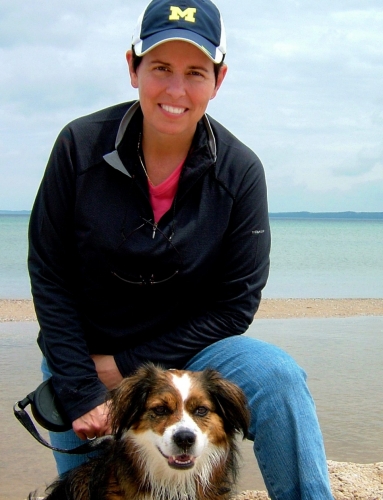
Elizabeth LaPorte
Now green space, the building I started my career working in was quirky. Like the movie "Being John Malkovich," the storage area on the second floor of this building was not quite the full ceiling height, forcing us to crouch and search for old project materials. Originally the medical library, this building was repurposed and renamed as one of the Kresge Science buildings, and housed a number of units.
Our team of illustrators, designers, photographers and videographers that worked in the Kresge building were quirky as well. As you might expect our creative group, Biomedical Communications (BMC), included many colorful people, and made work fun. In 1988, I joined this "creative services" arm of the Medical School and medical campus and worked there for about a decade.
We embraced the challenge of creating engaging medical science products for educational, research and promotional purposes. Our bread and butter work featured the development of research poster sessions (display posters), at a time when we were just beginning to leverage the power of personal computers. Four small Macintosh computers that required floppy disks were our tools to push the limits of the new digital age.
Wax and glue: Predigital design tools
There were two camps to the production process: wax and glue. At this point, the layout process for publications and posters involved sticking galleys with typeset copy to backing board. The "wax" group of designers turned on their warming machines first thing in the morning. The "glue" group of designers used rubber cement that came in bottles with brushes. Each group thought their type of adhesive was best. To produce research posters, we used the computer to print the text and adhered the printed sheets of paper with text to color matt board, the same board used for framing pictures.
A key point of innovation in display poster development came when one staff member tried something new: creating a one-piece display poster on a large printout (a photostat) of text and graphics that one could roll up and fit into a small carrying tube. These one-piece posters looked more professional and easily fit into overhead bins on airplanes, rather than multiple pieces of matt board that took up half of a suitcase.
Researchers loved the new poster format and raved about how easy it was to roll them out and pin them up in minutes. Some received awards for best display poster at conferences. The one improvement they suggested: add color. Most U-M design students like me used Pantone color film to mock up publications. So BMC staff became adept at adding color film, as well as color images to one-piece display posters.
Before the age of desktop color printers, designers produced elaborate mock-ups to show clients what color might look like once the final artwork was printed on a typical offset printing press. The designers shared a large common space, and music was a key part of our day, along with learning about families, personal challenges and often, eating together. We also learned about the work of many scientists.
A scientist who never slept
U-M researchers were on the cutting edge of coming up with a host of innovative surgical techniques, and a treatment regimen for HIV-AIDS. I worked with a young scientist that was so dedicated to her work, I wondered if she ever slept. We worked together to create a display poster for a series of conferences she was attending. The poster highlighted her effort to developed an algorithm to assist clinicians in determining what drugs to prescribe HIV-AIDS patients. Like many of the scientists I have had the pleasure to work with during my career, she was dogged in her quest to innovate and tackle "wicked" problems that improve and sometimes save lives.
In addition to researchers, BMC worked with program administrators, department managers and others to help communicate key information to faculty, students, staff and others. One such administrator is Laurita Thomas, then director of the Medical Center (now Health System) Human Resources. She assigned her staff member Sunny Roller the job of coordinating the design and production of a new calendar, intended to celebrate racial, gender, cultural and other types of diversity. An incredibly positive person, Sunny did not let being in a wheel chair slow her down. Working with Sunny, I designed two calendars that were distributed throughout the Medical Center for two years.
Laurita Thomas: Passionate advocate for staff
Since this time, Laurita has advanced to the position of Associate Vice President for Human Resources for the entire campus. She still remains passionate about advocating for staff, in the same way U-M researchers are passionate about their work. The development of the Voices of the Staff, and the online Career Path Navigator are just a couple of important staff resources developed during Laurita's tenure. A few years ago, I participated in Voices of the Staff and worked with very thoughtful people on great projects. Also, I've used the Career Navigator to explore career options, transitioning from design and art direction, to communications and outreach.
Reflecting on my experiences, I value the people I worked with along the way. I have learned from them, and often remark on how lucky I am to be an alumna and spend my career working with so many people from all walks of life. It's a beautiful thing to have a rewarding career at U-M.
Contributed by Elizabeth LaPorte, Science Outreach Manager, U-M Graham Sustainability Institute